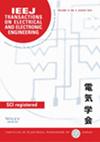求助PDF
{"title":"Continuous On-Chip Synthesis of Ag Nanoparticles Assisted by Resonant Microwave Heating Using a Post-Wall Waveguide","authors":"Kaito Fujitani, Mitsuyoshi Kishihara, Munehiro Sugiyama, Yuichi Utsumi","doi":"10.1002/tee.24169","DOIUrl":null,"url":null,"abstract":"<p>Microfluidics made of dimethylpolysiloxane were developed for chemical synthesis using microwave heating at 24.125 GHz, and microwave efficiency was enhanced by the microwave resonance effect. In addition, the device was fabricated using a mold created using a 3D printer to reduce production costs. The microchip structure comprised a post-wall waveguide and a microchannel that passed through the waveguide. This post-wall waveguide also comprises metal columns (post-wall) instead of a conductor side wall, and easily introduces microchannels through the gaps between the metal columns. The waveguide length was adjusted to achieve a resonance frequency of 24 GHz using an electromagnetic wave simulation, assuming that the microchannel was filled with pure water. Microwaves with an input power of 4 W caused a maximum temperature increase of 93 °C; this result is ~10 °C higher than that of a microchip with non-resonant structure. In this study, Ag nanoparticles were synthesized using a chemical reaction induced by microwave irradiation of a chip flow system. Owing to irradiating the mixing reagent with microwaves of an input power of 4 W while controlling the flow rate at 0.7 μl/min, the formation of Ag nanoparticles with an average particle size of ~19.2 ± 2.4 nm was demonstrated by absorbance measurements and dynamic light scattering. It is expected that microwave microfluidics enhanced by the resonance effect will substantialize nanoparticle synthesis and high-efficiency automated chemical synthesis combined with multichemical unit operations. © 2024 Institute of Electrical Engineers of Japan and Wiley Periodicals LLC.</p>","PeriodicalId":13435,"journal":{"name":"IEEJ Transactions on Electrical and Electronic Engineering","volume":"19 12","pages":"2072-2080"},"PeriodicalIF":1.0000,"publicationDate":"2024-07-18","publicationTypes":"Journal Article","fieldsOfStudy":null,"isOpenAccess":false,"openAccessPdf":"","citationCount":"0","resultStr":null,"platform":"Semanticscholar","paperid":null,"PeriodicalName":"IEEJ Transactions on Electrical and Electronic Engineering","FirstCategoryId":"5","ListUrlMain":"https://onlinelibrary.wiley.com/doi/10.1002/tee.24169","RegionNum":4,"RegionCategory":"工程技术","ArticlePicture":[],"TitleCN":null,"AbstractTextCN":null,"PMCID":null,"EPubDate":"","PubModel":"","JCR":"Q4","JCRName":"ENGINEERING, ELECTRICAL & ELECTRONIC","Score":null,"Total":0}
引用次数: 0
引用
批量引用
Abstract
Microfluidics made of dimethylpolysiloxane were developed for chemical synthesis using microwave heating at 24.125 GHz, and microwave efficiency was enhanced by the microwave resonance effect. In addition, the device was fabricated using a mold created using a 3D printer to reduce production costs. The microchip structure comprised a post-wall waveguide and a microchannel that passed through the waveguide. This post-wall waveguide also comprises metal columns (post-wall) instead of a conductor side wall, and easily introduces microchannels through the gaps between the metal columns. The waveguide length was adjusted to achieve a resonance frequency of 24 GHz using an electromagnetic wave simulation, assuming that the microchannel was filled with pure water. Microwaves with an input power of 4 W caused a maximum temperature increase of 93 °C; this result is ~10 °C higher than that of a microchip with non-resonant structure. In this study, Ag nanoparticles were synthesized using a chemical reaction induced by microwave irradiation of a chip flow system. Owing to irradiating the mixing reagent with microwaves of an input power of 4 W while controlling the flow rate at 0.7 μl/min, the formation of Ag nanoparticles with an average particle size of ~19.2 ± 2.4 nm was demonstrated by absorbance measurements and dynamic light scattering. It is expected that microwave microfluidics enhanced by the resonance effect will substantialize nanoparticle synthesis and high-efficiency automated chemical synthesis combined with multichemical unit operations. © 2024 Institute of Electrical Engineers of Japan and Wiley Periodicals LLC.
利用壁后波导在共振微波加热辅助下进行银纳米粒子的片上连续合成
利用 24.125 GHz 的微波加热技术开发了二甲基聚硅氧烷微流体用于化学合成,微波共振效应提高了微波效率。此外,为了降低生产成本,该装置是用三维打印机制作的模具制造的。微芯片结构包括一个壁后波导和一个穿过波导的微通道。这种后壁波导还包括金属柱(后壁),而不是导体侧壁,通过金属柱之间的间隙很容易引入微通道。假定微通道内充满纯水,通过电磁波模拟调整波导长度,使共振频率达到 24 千兆赫。输入功率为 4 W 的微波导致最高温度升高 93 °C;这一结果比非谐振结构的微芯片高出约 10 °C。在这项研究中,利用微波辐照芯片流系统诱导的化学反应合成了银纳米粒子。由于用输入功率为 4 W 的微波辐照混合试剂,同时将流速控制在 0.7 μl/min 的水平,通过吸光度测量和动态光散射证明形成了平均粒径为 ~19.2 ± 2.4 nm 的银纳米粒子。通过共振效应增强的微波微流控技术有望大幅提高纳米粒子合成和结合多化学单元操作的高效自动化化学合成的效率。© 2024 日本电气工程师学会和 Wiley Periodicals LLC。
本文章由计算机程序翻译,如有差异,请以英文原文为准。

 求助内容:
求助内容: 应助结果提醒方式:
应助结果提醒方式:


